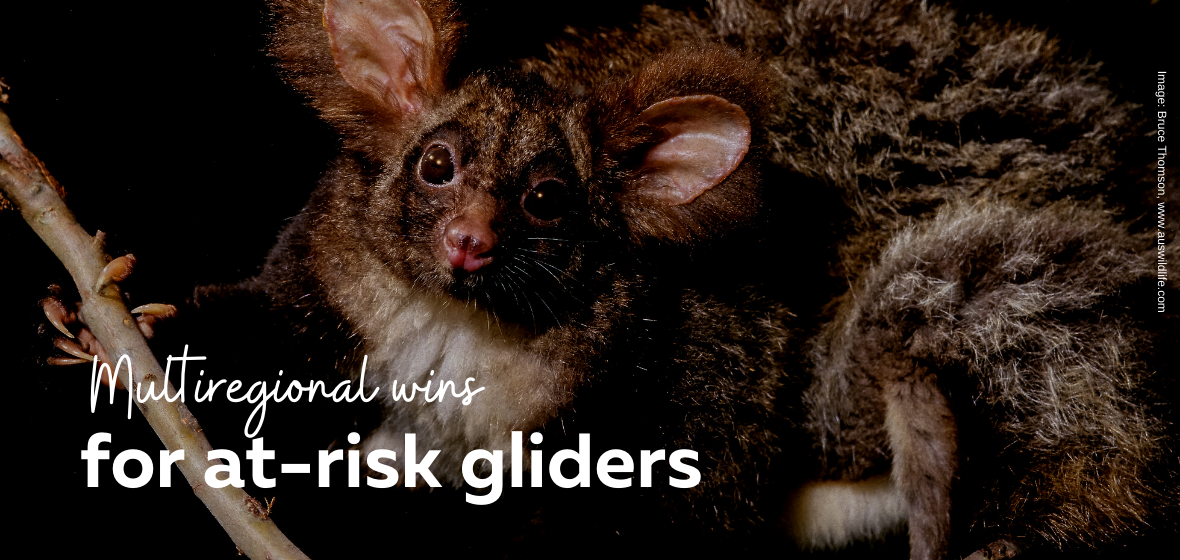14 February 2022
Wildlife Queensland is proud to announce that the Queensland Glider Network (QGN) is a successful recipient of Federal Government funding to improve community knowledge of endangered greater gliders and vulnerable yellow-bellied gliders across south-eastern Queensland’s fire-affected regions.
The Regional Bushfire Recovery for Multiregional Species and Strategic Projects Program – Grant from the Federal Government Department of Agriculture, Water and Environment awarded the Queensland Glider Network a total of $126,500 late last year for projects including:
- wildlife surveying and camera monitoring on private properties in fire-affected regions
- creation of comprehensive glider-specific revegetation guidelines
- and community engagement workshops across regions that were impacted by bushfires in late 2019 and early 2020.
The funding will help the Queensland Glider Network provide local communities and landholders in fire-affected areas with the knowledge, skills and information to implement recovery actions for endangered southern greater gliders (Petauroides volans southern and central) and vulnerable yellow-bellied gliders (Petaurus australis). Already, a chain of educational workshops, ‘shine & dine’ spotlighting events, and community engagement activities throughout Logan and the Scenic Rim for March and April are being organised.
Get yourself along to a glider event
“April will be a stellar month for these gliding marsupials, which represent Australia’s two largest glider species,” says Paul Revie, a Project Officer for QGN. “We have back-to-back weekends of glider engagement planned, starting with a ‘Dine & Shine’ half-day glider workshop on Saturday 5 March. People can come and learn how to build and install nest boxes or what eucalypt species will provide homes or feed trees for these gliders. They can even get up close with some gorgeous smaller gliding marsupials thanks to Geckoes Wildlife Presentations attending some events.”
Greater glider and yellow-bellied glider populations are in decline across their Queensland range due to landscape modification, habitat loss and the adverse effects of climate change. The 2019–2020 bushfires, which destroyed swathes of the Main Range and Crow’s Nest areas, could have ongoing implications for these gliders.
To assist property managers, landholders, and locals in identifying and preserving vital habitat, food trees and hollows, a comprehensive vegetation management guide, compiled with the assistance of the Queensland Herbarium, will also be created. Explaining which tree species these gliders require, and the best planting density, soil preparation, and fencing or corridor placement to protect revegetated habitat will ensure landholders are at the forefront of long-term glider recovery. The guide will be distributed free to landholders as an online flipbook, a downloadable PDF and a printed flyer.
“Greater gliders and yellow-bellied gliders are both eucalypt specialists, with the greater glider feeding solely on leaves and buds while the yellow-bellied glider is an energetic sapsucker, tapping into the limbs of several eucalypt species to obtain sap and visiting the same tree for years,” explains Josh Bowell, QGN Project Officer and founder of the Yellow-Bellied Glider Project. “Both species rely on hollow-bearing trees for nest sites, with yellow-bellied gliders often denning together in small family groups.”
While QGN is still unravelling some of the mysteries of how these gliders choose hollows or food trees, the team is always on hand to help landowners figure out whether vegetation on their land is a good fit for these gliders, how to tell whether any trees bear signs of feeding or denning, and what trees people can plant to help today’s gliders and future generations of tree-living marsupials too.
Revitalising post-fire regions
QGN and YBGP have proven success in engaging landholders in cooperative glider surveys on private properties across Logan and the south-east – data collection that is important for understanding the distribution of these gliders. This funding will help QGN continue that success in regions across the Scenic Rim, where post-fire recovery is ongoing and hollows and food trees are in high demand.
QGN will work closely with local landcare groups, and conservation and community groups to identify properties impacted by bushfires neighbouring fire-affected land that is likely to contain these gliders. Cameras and acoustic monitors will be purchased and installed, with landholder permission, to monitor for gliders.
“We’re hoping that some of the property owners who attend the workshops and events will be keen to let us do some non-invasive spotlighting, infra-red camera and/or acoustic surveys for these threatened species,” adds QGN Project Officer Matt Cecil. “Crown land and protected areas in South East Queensland simply aren’t large enough to sustain high numbers of these big gliders in the long-term, so we want property owners to tap us on the shoulder and say, ‘Hey, I might have seen something swooping about my place, do you think it could be a greater glider?’ The good news is that it just might be – especially if that land borders tracts of known habitat or national park.”
Every glider counts because catastrophic events such as unpredictable bushfires or damaging storms can drastically reduce populations at any time. Determining where these species are clinging on in pockets of habitat is crucial to preventing further declines.
“It’s great to be able to see gliders up close in a wildlife presentation or when spotlighting, but the real aim is to keep these marsupials thriving in the wild,” Cecil adds. “With the help of grant-funding like this, and the enthusiasm of landowners and locals, I believe we can achieve much better outcomes for these lovely large glider species.”
The projects add to those undertaken across the Scenic Rim under the same grant funding by Wildlife Queensland’s PlatypusWatch network. Wildlife Queensland thanks the Department of Agriculture, Water and Environment for making available much-needed funds for post-fire conservation programs.
Supported by the Australian Government’s Bushfire Recovery for Wildlife and their Habitats program.

